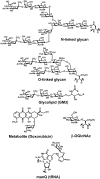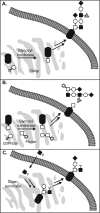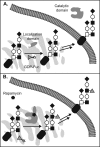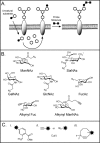Chemical approaches to perturb, profile, and perceive glycans
- PMID: 19361192
- PMCID: PMC2697281
- DOI: 10.1021/ar800267j
Chemical approaches to perturb, profile, and perceive glycans
Abstract
Glycosylation is an essential form of post-translational modification that regulates intracellular and extracellular processes. Regrettably, conventional biochemical and genetic methods often fall short for the study of glycans, because their structures are often not precisely defined at the genetic level. To address this deficiency, chemists have developed technologies to perturb glycan biosynthesis, profile their presentation at the systems level, and perceive their spatial distribution. These tools have identified potential disease biomarkers and ways to monitor dynamic changes to the glycome in living organisms. Still, glycosylation remains the underexplored frontier of many biological systems. In this Account, we focus on research in our laboratory that seeks to transform the study of glycan function from a challenge to routine practice. In studies of proteins and nucleic acids, functional studies have often relied on genetic manipulations to perturb structure. Though not directly subject to mutation, we can determine glycan structure-function relationships by synthesizing defined glycoconjugates or by altering natural glycosylation pathways. Chemical syntheses of uniform glycoproteins and polymeric glycoprotein mimics have facilitated the study of individual glycoconjugates in the absence of glycan microheterogeneity. Alternatively, selective inhibition or activation of glycosyltransferases or glycosidases can define the biological roles of the corresponding glycans. Investigators have developed tools including small molecule inhibitors, decoy substrates, and engineered proteins to modify cellular glycans. Current approaches offer a precision approaching that of genetic control. Genomic and proteomic profiling form a basis for biological discovery. Glycans also present a rich matrix of information that adapts rapidly to changing environs. Glycomic and glycoproteomic analyses via microarrays and mass spectrometry are beginning to characterize alterations in glycans that correlate with disease. These approaches have already identified several cancer biomarkers. Metabolic labeling can identify recently synthesized glycans and thus directly track glycan dynamics. This approach can highlight changes in physiology or environment and may be more informative than steady-state analyses. Together, glycomic and metabolic labeling techniques provide a comprehensive description of glycosylation as a foundation for hypothesis generation. Direct visualization of proteins via the green fluorescent protein (GFP) and its congeners has revolutionized the field of protein dynamics. Similarly, the ability to perceive the spatial organization of glycans could transform our understanding of their role in development, infection, and disease progression. Fluorescent tagging in cultured cells and developing organisms has revealed important insights into the dynamics of these structures during growth and development. These results have highlighted the need for additional imaging probes.
Figures






Similar articles
-
Recent progress in chemoenzymatic synthesis of human glycans.Org Biomol Chem. 2024 Oct 2;22(38):7767-7785. doi: 10.1039/d4ob01006j. Org Biomol Chem. 2024. PMID: 39246045 Review.
-
Quantitative O-glycomics based on improvement of the one-pot method for nonreductive O-glycan release and simultaneous stable isotope labeling with 1-(d0/d5)phenyl-3-methyl-5-pyrazolone followed by mass spectrometric analysis.J Proteomics. 2017 Jan 6;150:18-30. doi: 10.1016/j.jprot.2016.08.012. Epub 2016 Aug 29. J Proteomics. 2017. PMID: 27585995
-
Glycan Labeling and Analysis in Cells and In Vivo.Annu Rev Anal Chem (Palo Alto Calif). 2021 Jul 27;14(1):363-387. doi: 10.1146/annurev-anchem-091620-091314. Annu Rev Anal Chem (Palo Alto Calif). 2021. PMID: 34314224 Review.
-
N-Glycomic Analysis of the Cell Shows Specific Effects of Glycosyl Transferase Inhibitors.Cells. 2021 Sep 4;10(9):2318. doi: 10.3390/cells10092318. Cells. 2021. PMID: 34571967 Free PMC article.
-
Chemical reporters to study mammalian O-glycosylation.Biochem Soc Trans. 2021 Apr 30;49(2):903-913. doi: 10.1042/BST20200839. Biochem Soc Trans. 2021. PMID: 33860782 Free PMC article. Review.
Cited by
-
Glycoinformatics in the Artificial Intelligence Era.Chem Rev. 2022 Oct 26;122(20):15971-15988. doi: 10.1021/acs.chemrev.2c00110. Epub 2022 Aug 12. Chem Rev. 2022. PMID: 35961636 Free PMC article. Review.
-
Glycoproteins and glycoproteomics in pancreatic cancer.World J Gastroenterol. 2016 Nov 14;22(42):9288-9299. doi: 10.3748/wjg.v22.i42.9288. World J Gastroenterol. 2016. PMID: 27895417 Free PMC article. Review.
-
A biosynthetic strategy for re-engineering the Staphylococcus aureus cell wall with non-native small molecules.ACS Chem Biol. 2010 Dec 17;5(12):1147-55. doi: 10.1021/cb100195d. Epub 2010 Oct 5. ACS Chem Biol. 2010. PMID: 20923200 Free PMC article.
-
Bioorthogonal Retro-Cope Elimination Reaction of N,N-Dialkylhydroxylamines and Strained Alkynes.J Am Chem Soc. 2021 Apr 21;143(15):5616-5621. doi: 10.1021/jacs.1c00885. Epub 2021 Apr 8. J Am Chem Soc. 2021. PMID: 33829777 Free PMC article.
-
Bioorthogonal labeling cell-surface proteins expressed in pancreatic cancer cells to identify potential diagnostic/therapeutic biomarkers.Cancer Biol Ther. 2015;16(10):1557-65. doi: 10.1080/15384047.2015.1071740. Epub 2015 Jul 15. Cancer Biol Ther. 2015. PMID: 26176765 Free PMC article.
References
-
- Apweiler R.; Hermjakob H.; Sharon N. On the frequency of protein glycosylation, as deduced from analysis of the SWISS-PROT database. Biochim. Biophys. Acta 1999, 1473, 4–8. - PubMed
-
- Jung E.; Veuthey A. L.; Gasteiger E.; Bairoch A. Annotation of glycoproteins in the SWISS-PROT database. Proteomics 2001, 1, 262–268. - PubMed
-
- Kasai H.; Nakanishi K.; Macfarlane R. D.; Torgerson D. F.; Ohashi Z.; McCloskey J. A.; Gross H. J.; Nishimura S. The structure of Q* nucleoside isolated from rabbit liver transfer ribonucleic acid. J. Am. Chem. Soc. 1976, 98, 5044–5046. - PubMed
-
- Mitra N.; Sharon N.; Surolia A. Role of N-linked glycan in the unfolding pathway of Erythrina corallodendron lectin. Biochemistry 2003, 42, 12208–12216. - PubMed
-
- Grobe K.; Ledin J.; Ringvall M.; Holmborn K.; Forsberg E.; Esko J. D.; Kjellen L. Heparan sulfate and development: Differential roles of the N-acetylglucosamine N-deacetylase N-sulfotransferase isozymes. Biochim. Biophys. Acta 2002, 1573, 209–215. - PubMed
Publication types
MeSH terms
Substances
Grants and funding
LinkOut - more resources
Full Text Sources
Other Literature Sources

